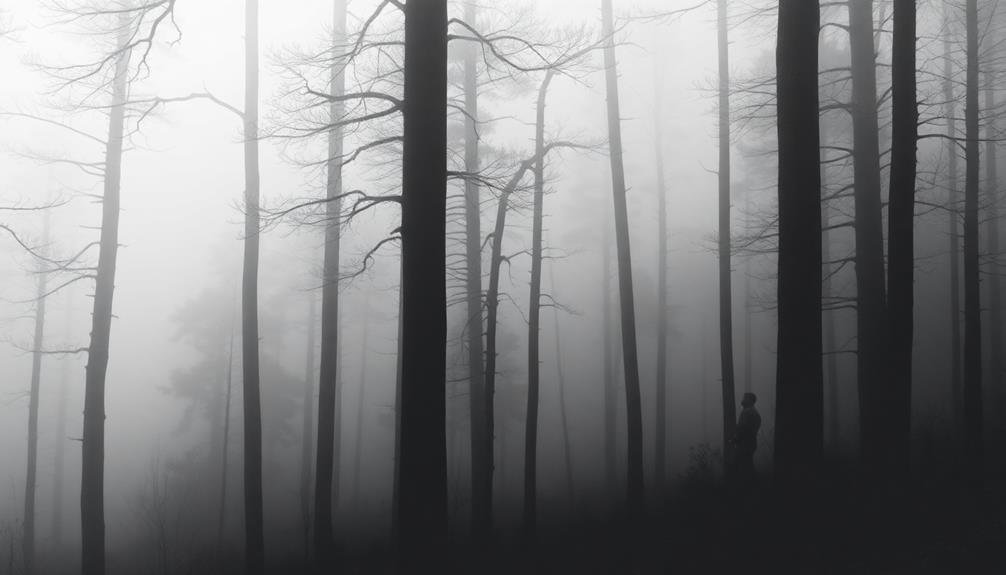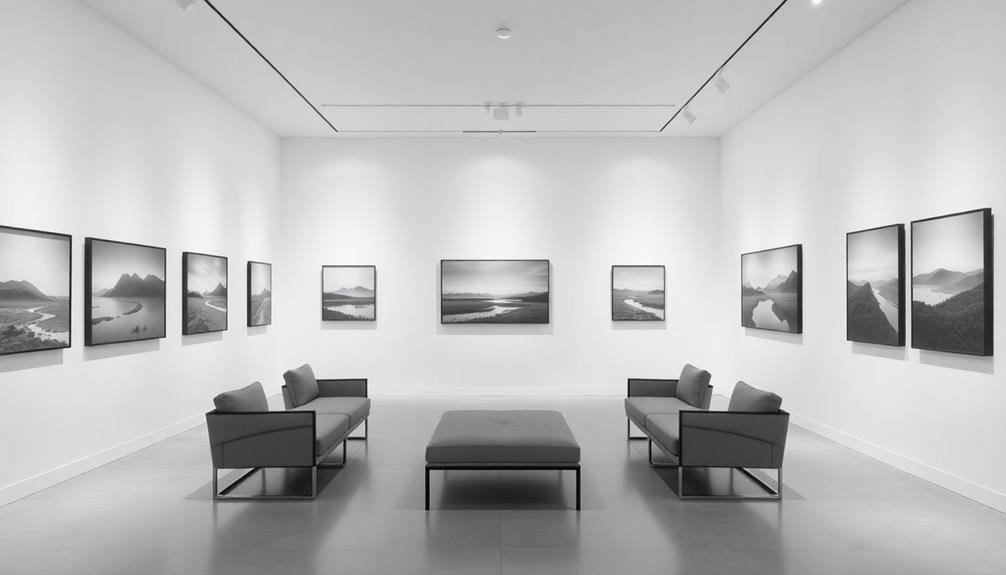Discover the calming power of monochrome photography with serene captures that soothe your mind. You'll learn to choose subjects that evoke tranquility, from gentle waves to architectural lines. Master composition techniques like the rule of thirds and negative space to create balanced, peaceful images. Harness light and shadow to add depth and drama while maintaining a serene atmosphere. You'll explore camera settings and post-processing tips to enhance your black-and-white shots. Whether you're capturing nature's beauty or finding urban serenity, these techniques will help you create a visual relaxation guide. Uncover the secrets to transforming everyday scenes into timeless, meditative works of art.
The Power of Monochrome Imagery

Why does a simple black-and-white image often captivate us more than a vibrant color photograph? The answer lies in the power of monochrome imagery to strip away distractions and focus our attention on the essence of a scene.
When you remove color, you're left with the raw elements of composition: light, shadow, texture, and form. Monochrome images force your brain to interpret the scene differently. Without color cues, you rely more on contrasts and shapes to understand what you're seeing.
This mental engagement can be deeply relaxing, as it encourages a form of visual meditation. You'll find yourself drawn into the details, noticing subtleties that might be overlooked in a color image.
Black-and-white photography also has a timeless quality that can transport you to a different era or emotional state. It evokes a sense of nostalgia or tranquility that's perfect for relaxation.
Choosing Subjects for Calming Photographs
When selecting subjects for calming photographs, three key elements should guide your choices: simplicity, natural beauty, and personal connection.
Opt for uncomplicated scenes that don't overwhelm the viewer. A lone tree in a field, a smooth pebble on a beach, or a solitary cloud in the sky can create a sense of tranquility through their simplicity.
Nature offers an abundance of soothing subjects. Consider capturing gentle waves lapping at the shore, dew-kissed leaves, or the graceful curves of sand dunes.
These natural elements often evoke a sense of peace and harmony. Don't overlook the calming potential of architectural subjects, such as the clean lines of a modern building or the weathered textures of an old barn.
Your personal connection to a subject can enhance its calming effect. Choose scenes that resonate with you emotionally, whether it's a favorite childhood spot or a place that holds special memories.
This personal touch won't only make your photographs more meaningful but also help convey a sense of serenity to your viewers.
Composition Techniques for Serene Scenes

Once you've chosen your calming subjects, it's time to contemplate how you'll frame them in your photographs. The rule of thirds is a classic technique that can create balance and visual interest. Imagine dividing your frame into a 3×3 grid and placing key elements along these lines or at their intersections.
Leading lines are another powerful tool. Use natural or man-made lines to guide the viewer's eye through the image, creating a sense of depth and tranquility. Curved lines, like winding paths or gentle waves, can be particularly soothing.
Negative space is vital for serene compositions. Don't be afraid to leave large areas of your frame empty, as this can create a sense of calm and allow the viewer's eye to rest.
Consider symmetry and reflection for peaceful scenes. A perfectly mirrored landscape in still water can evoke a sense of harmony and balance.
Lastly, pay attention to the horizon line. Keeping it straight is often essential for a serene feel, while placing it in the upper or lower third of the frame can emphasize either the sky or the foreground, depending on your subject.
Mastering Light and Shadow
To create truly serene images, understanding and mastering light and shadow is vital. Start by observing how light interacts with your subject throughout the day. Soft, diffused light often works best for calming scenes, so consider shooting during the golden hour or on overcast days.
Pay attention to the direction of light and how it affects the mood of your composition. Embrace shadows as they can add depth and drama to your monochrome images. Use them to create contrast and guide the viewer's eye through the frame.
Experiment with side-lighting to emphasize textures and forms. Don't be afraid of high-contrast scenes; they can evoke powerful emotions when done right. When shooting, expose for the highlights to preserve detail in bright areas.
You can always recover shadow details in post-processing. Use spot metering to guarantee accurate exposure of your main subject. Consider using graduated neutral density filters to balance exposure between bright skies and darker foregrounds.
In post-processing, fine-tune your images by adjusting contrast, highlights, and shadows. Dodge and burn specific areas to enhance the interplay of light and shadow, creating a more impactful and serene final image.
Camera Settings for Monochrome Shots

For capturing stunning monochrome shots, your camera settings play a crucial role. Start by switching your camera to its monochrome or black-and-white mode. This allows you to see the scene in grayscale through your viewfinder or LCD screen, helping you focus on tonal contrasts.
Set your ISO lower for cleaner images with less noise, typically between 100-400 in good lighting conditions. Adjust your aperture based on your desired depth of field; use a wider aperture (lower f-number) for a shallow depth of field or a narrower aperture for greater sharpness throughout the image.
When it comes to shutter speed, consider the mood you're trying to convey. Faster speeds freeze motion, while slower speeds can create a sense of movement or flow.
Don't forget to use exposure compensation to fine-tune your highlights and shadows. Experiment with your camera's contrast settings to enhance the distinction between light and dark areas.
If your camera offers custom picture profiles, create one specifically for monochrome shooting with increased contrast and sharpness. Finally, always shoot in RAW format to retain maximum editing flexibility in post-processing.
Post-Processing for Peaceful Black-and-White
When editing your monochrome images for relaxation, focus on gentle contrast adjustments to maintain a soothing atmosphere.
You'll want to avoid harsh blacks and whites, instead aiming for soft, calming tones throughout the image.
Create peaceful gradients by carefully balancing your highlights, midtones, and shadows to guide the viewer's eye smoothly across the frame.
Gentle Contrast Adjustments
Subtle tweaks in contrast can transform a black-and-white image into a peaceful visual experience. When adjusting contrast for serene monochrome captures, you'll want to strike a delicate balance between definition and softness.
Start by making small adjustments to the overall contrast, then fine-tune the highlights and shadows separately.
To achieve a calming effect, focus on:
- Softening harsh highlights to prevent eye strain
- Gently lifting shadows to reveal subtle details
- Maintaining a smooth tonal gradient across the image
Avoid pushing the contrast too far, as this can create a stark, dramatic look that detracts from the tranquil mood you're aiming for. Instead, aim for a gentle enhancement that guides the viewer's eye through the image without jarring shifts.
Experiment with the clarity or texture sliders in your editing software to add a touch of definition without oversharpening.
Soothing Grayscale Gradients
Building on the foundation of gentle contrast adjustments, mastering soothing grayscale gradients is key to creating truly peaceful black-and-white images.
You'll want to focus on smooth shifts between tones, avoiding harsh edges or abrupt changes that can disrupt the serene atmosphere.
Start by identifying the main light source in your image and visualize how it naturally illuminates the scene. Use this understanding to guide your gradient adjustments, ensuring they follow the logical flow of light.
Experiment with subtle variations in brightness across different areas of the photo, creating a soft, dreamy effect that draws the viewer's eye gently through the composition.
Don't shy away from deep blacks or bright whites, but use them sparingly as anchors for your gradients. The goal is to achieve a balanced range of grays that evoke a sense of calm.
Pay special attention to shadow areas, where you can introduce delicate gradients to reveal subtle details without compromising the overall mood.
Creating Mood Through Tonal Range

To create a serene mood in your black-and-white images, focus on balancing shadows and highlights effectively.
You'll want to pay close attention to the interplay between light and dark areas, ensuring neither dominates the frame excessively.
Shadows and Highlights Balance
The interplay between shadows and highlights in an image creates a powerful tonal range that can significantly influence mood.
When you're aiming for a serene monochrome capture, balancing these elements is essential. You'll want to pay close attention to how light and shadow interact within your frame, as this balance can dramatically affect the overall feeling of your photograph.
To achieve a harmonious balance:
- Expose for the highlights to preserve detail in the brightest areas
- Use the zone system to guarantee a full range of tones from black to white
- Experiment with different lighting conditions to find the perfect balance
Grayscale Gradation Techniques
While shadows and highlights create contrast, grayscale gradation techniques allow you to fine-tune the mood of your monochrome images. By manipulating the tonal range, you'll evoke specific emotions and atmospheres in your photographs.
Start by identifying the key areas of your image where gradual tonal shifts can enhance the overall feel. Soft gradations often convey tranquility, while steeper shifts may suggest drama or tension. Use editing tools to adjust the brightness and contrast of specific regions, creating smooth transitions between light and dark areas.
Consider these grayscale gradation techniques to achieve different moods:
| Technique | Effect | Mood |
|---|---|---|
| Soft Gradients | Gentle shifts | Calm, dreamy |
| High Contrast | Sharp tonal changes | Dramatic, intense |
| Low Contrast | Muted tones | Mysterious, ethereal |
Experiment with various combinations to find the perfect balance for your image. Remember, subtle adjustments can have a significant impact on the viewer's perception. By mastering grayscale gradation techniques, you'll enhance your ability to create compelling, emotive monochrome photographs that captivate and relax your audience.
Minimalism in Monochrome Photography
In monochrome photography, minimalism strips away distractions, leaving only the essence of an image. By focusing on simplicity and negative space, you'll create powerful, emotive compositions that captivate viewers.
Embrace clean lines, geometric shapes, and stark contrasts to evoke a sense of calm and contemplation.
When composing minimalist monochrome shots, consider these key elements:
- Balance: Use the rule of thirds or symmetry to create harmonious compositions
- Texture: Highlight subtle surface details to add depth and interest
- Contrast: Leverage the interplay of light and shadow to define your subject
To achieve striking minimalist results, look for isolated subjects against clean backgrounds. Seek out architectural details, lone trees in open fields, or solitary figures in expansive landscapes.
Don't be afraid to experiment with extreme negative space, allowing your subject to occupy only a small portion of the frame.
Nature as a Source of Tranquility

Nature offers unparalleled tranquility, and you'll find it captured beautifully in black-and-white forest photographs.
You can lose yourself in misty mountain landscapes that evoke a sense of mystery and calm.
Serene shoreline scenes, with their rhythmic waves and expansive horizons, provide another powerful source of visual relaxation.
Forests in Black-and-White
Black-and-white forest images strip away the distractions of color, allowing you to focus on the essence of nature's tranquility. In these monochrome scenes, you'll notice the intricate patterns of tree bark, the delicate silhouettes of leaves, and the interplay of light and shadow.
The absence of color heightens your perception of texture and form, creating a serene atmosphere that's both calming and contemplative. As you gaze at these images, you'll find yourself drawn into the quiet world of the forest.
The stark contrast between dark tree trunks and bright clearings guides your eye through the composition, inviting you to explore every detail. You'll discover a new appreciation for the subtle gradations of gray that reveal the forest's depth and complexity.
To fully immerse yourself in the peaceful ambiance of black-and-white forest photography:
- Focus on the patterns and textures created by tree branches and foliage
- Observe how light filters through the canopy, creating dramatic shadows
- Pay attention to the balance between light and dark areas in the image
These monochrome forest scenes offer a unique perspective on nature's beauty, encouraging mindfulness and relaxation.
Misty Mountain Landscapes
Shrouded in ethereal mist, mountain landscapes offer a profound source of tranquility and visual serenity. As you gaze upon these monochrome scenes, you'll find yourself transported to a world of quiet contemplation. The gentle gradients of gray, from deep charcoal to soft silver, create a sense of depth and mystery that captivates the eye.
Focus on the interplay of light and shadow as it dances across the misty peaks. You'll notice how the fog softens harsh edges, blending rugged terrain into smooth, dreamlike contours. This softening effect invites your mind to wander and explore the hidden depths of the landscape.
Pay attention to the subtle textures revealed in black and white: the rough bark of distant trees, the smooth face of weathered rocks, and the delicate wisps of mist curling through valleys. These details, often overlooked in color photography, take on new significance in monochrome.
As you immerse yourself in these misty mountain vistas, you'll feel your breathing slow and your muscles relax. The timeless quality of these scenes encourages a meditative state, allowing you to momentarily escape the chaos of daily life and find peace in nature's quiet grandeur.
Serene Shoreline Scenes
As waves gently lap against the shore, serene coastal scenes offer a powerful antidote to stress and anxiety.
You'll find that shoreline vistas can transport you to a state of calm, allowing your mind to unwind and your body to relax. The rhythmic ebb and flow of the tide creates a soothing soundtrack, while the expansive horizon invites your gaze to wander and your thoughts to drift.
To fully immerse yourself in these tranquil scenes:
- Focus on the interplay of light and water, observing how sunlight dances on the waves or how moonlight casts a silvery path across the sea.
- Notice the textures of sand, pebbles, or weathered driftwood beneath your feet, grounding yourself in the present moment.
- Listen for the calls of seabirds or the whisper of sea grass in the breeze, connecting with nature's subtle symphony.
Urban Serenity in Black and White
City streets, often bustling with chaos, can transform into havens of tranquility when viewed through a monochromatic lens. Black and white photography strips away the distractions of color, allowing you to focus on the essence of urban landscapes. You'll find yourself drawn to the interplay of light and shadow, the geometric patterns of architecture, and the subtle textures of city life.
To capture urban serenity in black and white, look for:
| Element | Example | Effect |
|---|---|---|
| Symmetry | Reflections in windows | Creates balance |
| Leading lines | Empty streets | Guides the eye |
| Negative space | Stark building facades | Evokes calm |
| Textures | Weathered brickwork | Adds depth |
As you explore the city, you'll discover peaceful moments in unexpected places. A solitary bench in a park, a quiet alleyway, or a mist-shrouded bridge can all become subjects for serene monochrome images. By focusing on these tranquil elements, you'll create a visual narrative that reveals the hidden calm within urban environments, offering viewers a moment of respite from the usual city rush.
Capturing Stillness in Motion

Motion surrounds us, but within its flow lies a hidden stillness waiting to be captured. As you explore this artistic technique, you'll discover the beauty of freezing moments in time through your lens. By adjusting your camera's settings, you can transform bustling scenes into serene, monochrome images that evoke a sense of calm.
To capture stillness in motion, you'll need to master the interplay of shutter speed, aperture, and ISO. Start with a fast shutter speed to freeze movement, then experiment with longer exposures to create dreamy, blurred effects.
Look for contrasts between static and moving elements in your environment, such as a stationary building against a busy street or a steady rock amid rushing water.
Consider these subjects for your stillness-in-motion photography:
- Water features: fountains, waterfalls, or ocean waves
- Urban landscapes: traffic streams, pedestrians, or rotating signage
- Nature scenes: swaying trees, flowing rivers, or flocking birds
As you practice, you'll develop an eye for finding tranquil moments within chaotic surroundings.
Textures and Patterns for Visual Calm
While capturing stillness in motion offers one path to visual relaxation, exploring textures and patterns can provide another powerful avenue for creating calm imagery. You'll find that focusing on these elements can bring a sense of order and rhythm to your photographs, promoting a feeling of tranquility.
When seeking textures and patterns for visual calm, consider these options:
| Natural Textures | Man-made Patterns |
|---|---|
| Sand ripples | Brick walls |
| Tree bark | Tile mosaics |
| Leaf veins | Window shutters |
| Rock formations | Fabric weaves |
| Water droplets | Architectural details |
To capture these elements effectively, you'll want to pay attention to lighting and composition. Soft, diffused light can enhance the subtle variations in texture, while side-lighting can create depth and shadow. When composing your shot, try filling the frame with the texture or pattern to create an immersive experience.
Don't be afraid to experiment with different angles and perspectives. Sometimes, getting up close to a texture can reveal intricate details that weren't visible from afar, adding an element of discovery to your visual relaxation practice.
Displaying Your Serene Monochrome Collection

A gallery of serene monochrome images can transform your living space into a calming sanctuary. When displaying your collection, consider the overall aesthetic and mood you want to create. Choose a focal wall or dedicated area where your images will have the most impact.
Arrange them in a cohesive manner, either symmetrically or asymmetrically, depending on your preference and the space available.
To enhance the calming effect of your monochrome collection:
- Use simple, minimalist frames that don't distract from the images
- Experiment with different sizes and orientations to create visual interest
- Group related images together to tell a story or evoke a specific emotion
Lighting plays an essential role in showcasing your serene captures. Opt for soft, diffused lighting that doesn't create harsh shadows or reflections on the glass.
Consider installing adjustable picture lights or track lighting to highlight specific pieces. Remember to rotate your collection periodically to keep your space feeling fresh and to prevent fading from prolonged exposure to sunlight.
Frequently Asked Questions
How Does Monochrome Photography Affect Viewers' Emotions Compared to Color Images?
You'll find monochrome photography often evokes stronger emotions than color images. It strips away distractions, focusing on form and contrast. You're more likely to feel nostalgia, melancholy, or tranquility when viewing black and white photos.
Can I Create Serene Monochrome Photos Using a Smartphone Camera?
Yes, you can create serene monochrome photos with your smartphone. Use your camera's black and white mode or edit color photos later. Focus on composition, lighting, and textures to capture peaceful scenes that evoke calm emotions.
What Are Some Ethical Considerations When Photographing People for Monochrome Relaxation Images?
When photographing people for monochrome relaxation images, you'll need to respect privacy, obtain consent, and avoid exploitation. Don't misrepresent your subjects or their emotions. Be mindful of cultural sensitivities and always prioritize the individual's dignity.
How Can I Incorporate Monochrome Photography Into My Mindfulness or Meditation Practice?
You can use monochrome photography in your mindfulness practice by focusing on shapes, textures, and light. Capture simple scenes, study the images, and reflect on their details. It'll help you stay present and appreciate subtle beauty.
Are There Any Cultural Differences in Perceiving Serenity Through Monochrome Imagery?
You'll find cultural differences in perceiving serenity through monochrome imagery. Eastern cultures often associate it with simplicity and balance, while Western viewers might see it as stark or dramatic. Your personal background shapes your interpretation.
In Summary
You've now explored the art of creating serene monochrome captures. Remember, it's not just about black and white; it's about evoking tranquility through your lens. As you practice these techniques, you'll find yourself seeing the world differently, appreciating the subtle beauty in everyday scenes. Don't be afraid to experiment and develop your unique style. Your serene monochrome collection will become a visual oasis, offering moments of calm in a hectic world.





Leave a Reply